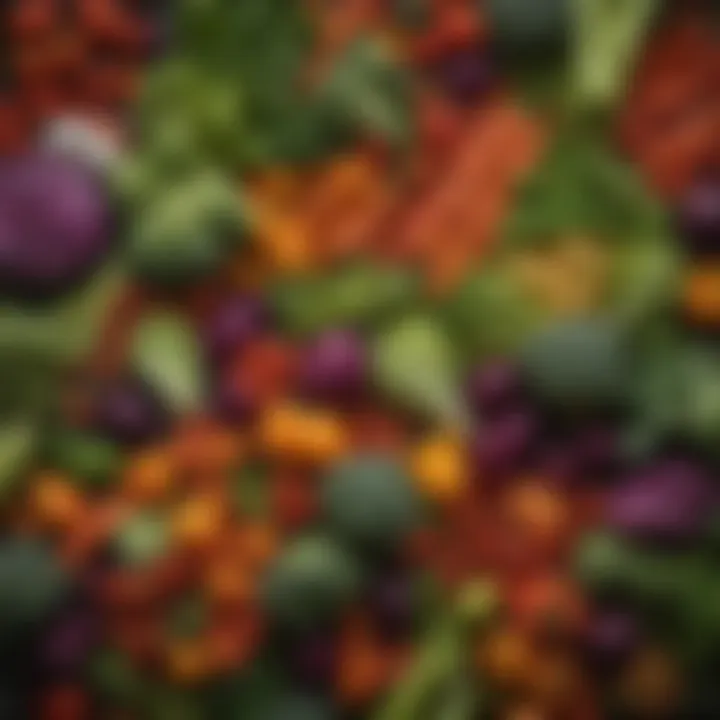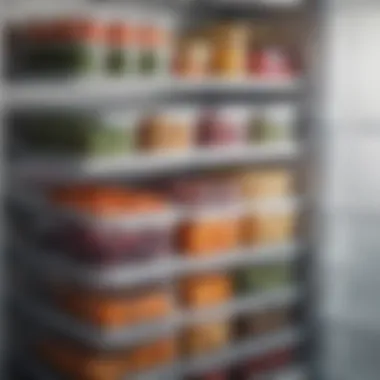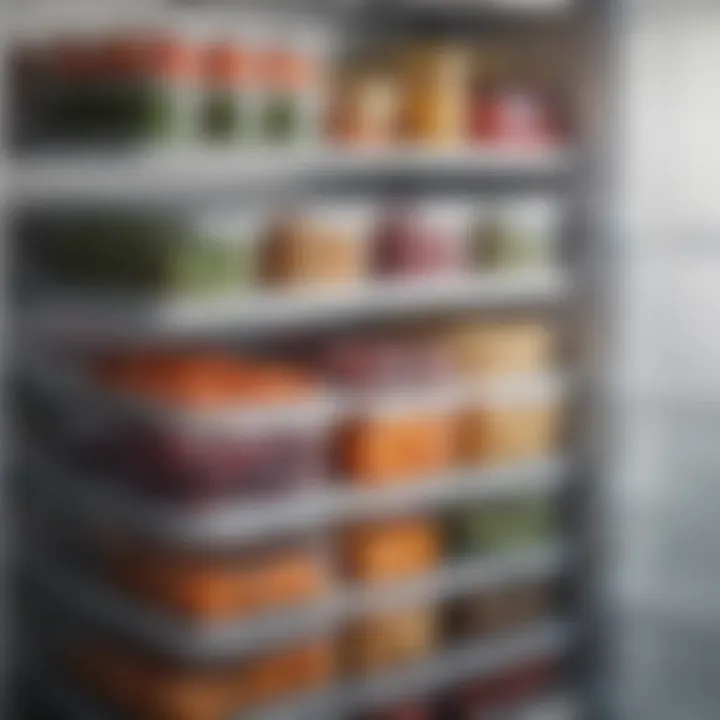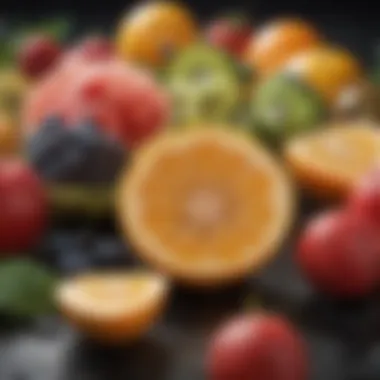Foods You Can Cook and Freeze: An In-Depth Guide


Intro
In contemporary culinary practice, meal preparation has become a rock-solid solution for those juggling busy schedules. Knowing which foods can be cooked and frozen is essential in achieving efficiency and convenience in meal planning. This guide will unfold a tapestry of dishes that not only hold flavor but also nutrition after storage.
When meal prep is executed correctly, it can significantly reduce food waste while enhancing one's repertoire of recipes. Understanding proper freezing techniques and storage methods forms the backbone of preserving the quality of your meals. However, misconceptions surrounding the freezing of food often emerge. By addressing these concerns and offering straightforward clarification, this guide aims to empower culinary enthusiasts from beginners to experts. Whether you are thinking about family dinners or solo lunches, you will find valuable insight to help you navigate the freezing process effectively.
Understanding the Concept of Freezing Food
Freezing food is an essential practice in modern culinary management. It allows individuals to prepare meals in advance and preserve their freshness over time. This section aims to clarify the key aspects of freezing food, emphasizing its advantages and some considerations to factor in when adopting this method.
The Basics of Freezing
The freezing process involves lowering the temperature of food to below 0 degrees Fahrenheit. This halts the growth of bacteria and preserves the cellular structure of the food. When food freezes quickly, large ice crystals do not form, which helps maintain texture and flavor. Understanding how freezing works is critical for maximizing the benefits of this preservation technique. It is not as simple as placing food in the freezer; it requires attention to preparation methods and appropriate storage practices.
Why Freeze Food?
Food preservation through freezing serves multiple purposes.
Convenience
One of the main reasons people choose to freeze food is convenience. With busy schedules, having ready-to-eat meals at hand simplifies meal planning. Cooking in bulk and freezing portions reduces daily cooking time. This particular aspect of convenience allows individuals to enjoy home-cooked meals without needing daily prep. However, one must ensure that meals are properly packaged and aligned with appropriate freezing methods to maintain the intended convenience. Without this care, meals can become less enjoyable due to taste alteration during long storage.
Nutrient Preservation
Nutrient preservation is another significant benefit of freezing food. When food is frozen, it retains much of its nutritional value, typically as long as it is stored correctly. In some cases, frozen food can have similar nutrient levels as fresh counterparts. However, not all foods freeze equally well; for example, leafy greens may lose some texture but generally keep their vitamins. The key to successful nutrient retention lies in quick freezing techniques and appropriate handling before and after freezing.
Cost Efficiency
Cost efficiency in freezing food is noteworthy. Often, buying ingredients in bulk and freezing them can be more economical than purchasing smaller portions repeatedly. This practice reduces food costs over time and helps families manage their budgets effectively. Additionally, it allows for utilizing seasonal produce, which is typically cheaper when in abundance. However, one must be mindful of maintaining the quality of frozen items; poor freezing practices can lead to food waste, negating cost benefits.
Waste Reduction
Finally, freezing food plays a crucial role in waste reduction. Many households deal with excessive food waste from uneaten leftovers or ingredients that spoil before use. By freezing surplus meals or ingredients, one can extend their life and reduce disposal costs. This can be considered both an economical and an environmentally friendly practice. A successful strategy in waste management involves planning meals carefully and recognizing items that are nearing their spoilage point to freeze them in time and thereby diminish waste.
"Freezing food is not just about storage. It’s a method that enhances convenience, preserves nutrients, and promotes cost savings while aiming for minimal waste."
The understanding of freezing food encompasses several elements that contribute to its practical applications. Mastering these can transform how individuals manage their meal planning and grocery supplies.
Types of Food Ideal for Freezing
Understanding which types of food perform best in the freezer is key for anyone looking to enhance meal preparation. Certain foods retain their quality and flavor after being frozen, while others may not fare as well. Selecting the right foods for freezing can lead to better meal planning, reduced waste, and enhanced convenience.
When it comes to freezing, it is not just about the food itself; preparation methods also play an essential role. Foods that can withstand freezing typically have a higher water content, and certain textures may be altered during the freezing process. In this section, we will dive into specific categories that are ideal for freezing, making your culinary efforts both more efficient and enjoyable.
Soups and Stews
Soups and stews are among the best candidates for freezing. They tend to maintain their flavors well, as the spices and ingredients meld together during cooking. When considering soups, choose those that have a good balance of broth, proteins, and vegetables.
Here are some types to consider for freezing:
- Chicken soup
- Chili
- Vegetable soup
To freeze soup effectively, allow it to cool before transferring it to airtight containers. It's important to leave space at the top, as liquids expand when frozen. Defrosting can be done easily by leaving them in the fridge overnight.
Casseroles
Casseroles are another versatile option for freezing. They combine various ingredients into one dish, making them convenient for meal prep. The key to proper freezing is to avoid recipes with high dairy content, as dairy can separately during thawing. Popular casseroles to freeze include:
- Chicken and rice casserole
- Vegetable lasagna
- Beef shepherd's pie
For best results, prepare your casserole, let it cool, and then cover tightly with foil or plastic wrap before freezing.
Meats and Proteins


Meats and proteins are essential for many dishes, and freezing can help preserve their flavor and texture. This includes raw and cooked meats. When freezing raw meat, ensure it is fresh and not approaching its expiration date.
When freezing meats, consider these points:
- Vacuum sealing is preferred to avoid freezer burn.
- Cut larger pieces into portions for easier cooking later.
- Marinating before freezing can enhance flavor upon thawing.
Examples of proteins that freeze well include:
- Chicken breasts
- Ground beef
- Salmon fillets
Vegetables
Vegetables can be frozen with some preparation to maintain their quality. To ensure optimal texture and flavor post-freezing, blanch vegetables before freezing them. This process involves boiling them for a short time and then plunging them into icy water to stop the cooking process.
Consider freezing:
- Green beans
- Carrots
- Peas
Blanching helps preserve color and nutrients, making your frozen vegetables more appetizing.
Fruits
Fruits can also be a great addition to your freezer. Many fruits freeze well and can be used in smoothies, desserts, or as snacks. Slicing them and removing any seeds or pits can improve usability later.
Fruits that freeze nicely include:
- Berries such as strawberries and blueberries
- Bananas (slice before freezing)
- Peaches (peeled and cubed)
Freezing fruits can help maintain their nutrients and flavor while providing convenient access year-round.
Baked Goods
Baked goods can be delightful when frozen, allowing you to enjoy fresh treats anytime. However, the texture may change slightly after being frozen and thawed. To maintain quality, consider how you plan to use them later.
Examples include:
- Bread (whole loaves or slices)
- Cookies (dough or baked)
- Muffins
Wrap baked goods tightly before freezing to prevent freezer burn. Once ready to use, thaw at room temperature or warm them briefly in the oven.
By knowing the ideal types of food to freeze, you can expand your culinary options and streamline your meal prep efforts effectively. Each of these categories offers flexibility and saves time, ensuring you always have something delicious on hand.
Preparation Techniques for Freezing
Freezing food is not merely about placing items in the freezer; it involves specific techniques that ensure quality, taste, and safety are preserved. Proper preparation is the cornerstone of effective freezing. It helps maintain the flavor and nutritional integrity of the food. Moreover, it can prevent common issues, such as freezer burn, which can render food unappetizing and decrease its shelf life. By understanding and applying best practices for preparation, anyone can elevate their meal prep game to new heights.
Cooking Methods Prior to Freezing
Before freezing, the cooking method used can significantly affect the final product. Certain types of foods benefit from being cooked beforehand. For example, soups, stews, and casseroles often taste better when prepared and frozen, as the flavors have time to meld together. Cooking methods such as blanching vegetables before freezing can maintain their color and texture. To blanch, simply immerse the vegetables in boiling water for a few minutes, then quickly transfer them to ice water. This process halts enzyme activity, ensuring that the vegetables retain their freshness.
For meats, cooking them to a safe internal temperature is critical. This step not only enhances flavor but also lowers the risk of foodborne illness. Grilling, baking, or sautéing proteins like chicken, beef, and fish can add layers of flavor that survive the freezing process. Furthermore, cooking methods like slow cooking can produce tender and flavorful meals that freeze well, ensuring the taste remains intact upon reheating.
Cooling and Packaging
Proper cooling and packaging of food is another vital step in the freezing process. After preparing food, it is essential to cool it down quickly to prevent bacterial growth. Placing hot food directly into the freezer can raise the temperature inside the freezer, risking the quality of other frozen items. Instead, allow foods to cool at room temperature for a short period before transferring them to the refrigerator. This step speeds up the cooling process without exposing food to unsafe temperatures for too long.
When it comes to packaging, selecting appropriate materials is key. Foods should be tightly wrapped to minimize air exposure. Options like plastic wrap, aluminum foil, or freezer-specific bags can effectively protect food from freezer burn. Glass containers are also a sustainable choice, as long as they are designed for freezing. It’s crucial to leave some headspace in containers to allow for expansion during freezing. This consideration helps maintain the structure and quality of the food.
Labeling and Dating Food
Labeling and dating food before freezing is often an overlooked but important step. It provides essential information that prevents confusion later. A clear label should include the dish name and the date it was prepared. This simple practice allows for better organization within the freezer, helping to rotate older items to the front and use them up first.
Also, include notes on reheating instructions, if necessary, to save time and ensure the best results when it's time to enjoy the meal. For example, a label could read: "Vegetable Soup - 09/15/2023 - Reheat on stove for 15 minutes until hot." This straightforward practice promotes a more efficient meal planning routine.
"Proper preparation techniques enhance not only the quality of frozen food but also the efficiency of meal planning."


Storage Techniques for Frozen Food
The methods used for storing frozen food are critical in maintaining quality, flavor, and safety over time. Proper storage techniques not only help to prevent freezer burn but also aid in retaining the nutritional value of the food. When done correctly, freezing can extend the life of meals without compromising their taste or texture. This section will delve into practical strategies for effective food storage.
Choosing the Right Containers
Choosing the right container for freezing food significantly influences its quality and longevity. Factors such as material, sealability, and usability are key to effective storage. Below are various options that serve different needs and preferences.
Plastic Bags
Plastic bags are a popular choice for freezing because they are flexible and take up less space in the freezer. These bags are designed to be airtight, which helps to prevent the introduction of air that can cause freezer burn. A major characteristic of plastic bags is that they are lightweight. This makes them easy to handle and ideal for portioning out meals.
The unique feature of plastic bags is their ability to mold to the shape of the food inside. This allows for more efficient storage since bags can fit into the crevices of your freezer.
However, plastic bags also have disadvantages. They can sometimes tear or puncture if mishandled. Additionally, not all plastic bags are safe for freezing, so selecting freezer-safe options is essential.
Glass Containers
Glass containers are another excellent option for freezing food. They are sturdy and can provide a good barrier against air. A key advantage of glass containers is their rigidity, which helps avoid spillage or crushing of the food inside them.
The unique feature of glass is that it is non-reactive, meaning it does not leach chemicals into the food, ensuring that the food retains its natural flavor and quality. Glass can also often be transferred directly from the freezer to the oven, adding to their convenience.
On the downside, glass containers are heavier compared to plastic and can break if dropped, requiring careful handling.
Plastic Containers
Plastic containers offer a blend of durability and cost-effectiveness, making them a commonly used choice for freezing food. These containers are usually available in various sizes, which allows for easy portioning of meals, making them a very practical option.
A defining characteristic of plastic containers is their resealability, allowing for repeated use without compromising the seal. They are also less likely to break compared to glass, providing a safer option in some households.
Nevertheless, plastic containers may not always provide the same airtight seal as other options, leading to potential freezer burn. Moreover, some plastics can warp or crack under cold temperatures, impacting their longevity.
Optimal Freezing Practices
To get the most out of your frozen food, optimal freezing practices should be observed. Here are several considerations to enhance the freezing process:
- Cool Food Before Freezing: Always allow cooked food to cool down prior to placing it in the freezer. This prevents temperature fluctuations that can affect the overall temperature of your freezer.
- Portion Your Meals: Dividing meals into smaller portions can facilitate faster freezing and easier thawing. This approach also allows for better control over serving sizes.
- Avoid Overcrowding: Ensure there is enough space around containers for air circulation. Proper air flow is necessary for consistent freezing, which helps to maintain quality.
Using these techniques can significantly enhance the quality and safety of frozen meals.
Defrosting Methods
Defrosting food properly is crucial when it comes to enjoying the meals you have prepared ahead of time. Incorrect defrosting can lead to issues such as uneven heating, bacterial growth, or loss of taste. Each method has its unique advantages and potential drawbacks. Understanding these methods ensures that frozen food remains safe, nutritious, and flavorful. Let’s explore three common defrosting methods: refrigerator thawing, cold water thawing, and microwave thawing.
Refrigerator Thawing
Refrigerator thawing is the most recommended method. It is safe and effective. This method involves transferring the frozen food from the freezer to the refrigerator and allowing it to thaw gradually over 24 hours, depending on the size and type of food.
Benefits:
- Safety: This method keeps food at a stable, safe temperature, minimizing the risk of bacterial growth.
- Quality Retention: Thawing in the refrigerator helps maintain the texture and taste of the food.
Considerations include planning ahead, as this method takes time. For instance, a large turkey might take several days to thaw completely. However, once defrosted, the food can remain in the fridge for an additional period before cooking. This allows for flexibility in meal planning.
Cold Water Thawing
Cold water thawing is another viable option for those needing food thawed more quickly. This method involves sealing the food in a waterproof plastic bag and submerging it in cold water.
Benefits:
- Speed: This method can thaw food within a few hours, depending on the size.
- Safety: Keeping the water cold helps reduce and minimize bacterial growth during thawing.
To ensure safety, it is important to change the water every 30 minutes. This prevents any parts of the food from rising above 40°F (4°C), which is critical to avoid harmful bacteria proliferation. This method is suitable for lean meats, fish, or smaller cuts.
Microwave Thawing


Microwave thawing is the quickest method for defrosting, making it suitable for unplanned meals. The microwave allows you to thaw food rapidly using the defrost setting, which uses low power to minimize cooking while thawing.
Benefits:
- Speed: This method takes only a few minutes, making it the fastest way to start cooking.
- Convenience: You can go directly from the freezer to the cooking process without significant downtime.
However, precautions are necessary. Sometimes, uneven heating can occur, which can partially cook some areas of the food. This could lead to a compromised texture. Thus, it’s recommended to cook the food immediately after thawing in the microwave.
Tip: Always cook food immediately after thawing it in the microwave to maintain safety and quality.
Common Misconceptions About Freezing Food
Freezing food is a practical solution for many individuals looking to enhance their meal preparation routines. However, there are persistent misconceptions that can lead to hesitance in utilizing this convenient method. Addressing these misconceptions is crucial as it allows people to make informed decisions regarding their food storage practices. It not only clarifies the realities of freezing but also highlights the benefits this method brings, such as preserving flavors and maintaining nutrition. Understanding these misconceptions helps ensure that food lovers can confidently embrace freezing as a reliable culinary strategy.
Taste and Texture
Many believe that freezing food compromises its taste and texture. This is not entirely accurate. The truth is, properly frozen food can maintain its original flavor and texture. Some foods freeze better than others, leading to varying experiences. For example, fruits like strawberries and blueberries often retain their taste well, while certain vegetables, like leafy greens, may become limp upon thawing.
It is also essential to acknowledge the role of preparation in preserving taste. Cooking methods preceding freezing, such as blanching vegetables, can improve the final dish's quality. Freezing a meal immediately after cooking locks in flavor, preventing oxidation or spoilage. Key tips include:
- Cool foods quickly before freezing.
- Use air-tight packaging to prevent freezer burn.
- Consume stored foods within a few months for optimal taste.
"Freezing does not ruin flavor. It just alters the experience if not handled properly."
Nutritional Value
Another common belief is that freezing significantly reduces a food item's nutritional value. Research indicates that freezing can preserve nutrients effectively when done correctly. For example, vegetables harvested at their peak ripeness can be blanched and frozen within hours. The process helps retain vitamins and minerals. This is particularly beneficial with seasonal produce, which can be frozen to enjoy nutritious meals year-round.
Nevertheless, it is important to recognize that some nutrient loss can occur during freezing or thawing. In general, more delicate items, such as berries, maintain their nutritional content better than others. To maximize nutrient preservation, consider the following:
- Freeze food at its peak freshness.
- Avoid long storage times; consume food within a reasonable period.
- Use methods like blanching for veggies before freezing.
In summary, while some misconceptions exist regarding freezing food, these can often be cleared with education about best practices. Freezing offers significant advantages, including taste retention and nutrient preservation, making it an invaluable technique in today’s fast-paced world.
Practical Tips for Successful Freezing
Freezing food is much more than just placing leftovers in the freezer. It requires thought and strategy to maximize the benefits of this preservation method. The aim is to maintain food quality while achieving convenience in meal prep. Understanding how to effectively freeze food can help minimize waste, save time, and ensure that meals retain their nutritional value.
Portion Control
Portion control plays a significant role in successful freezing. When food is portioned correctly, it allows for easy meal planning and avoids unnecessary defrosting of larger batches. Breaking down meals into single or family-sized portions can help maintain freshness and flavor. For instance, when preparing chili, consider freezing it in individual servings. This way, you can take out just what you need without affecting the rest.
Using containers of various sizes can ease the storage and thawing process. It is also wise to think about the meals you eat regularly and prepare those in advance. By having ready-to-cook portions, you reduce cooking time on busy days.
To assist with this, using guidelines for portioning can be beneficial. Here are some tips:
- Use freezer-safe containers and bags.
- Label servings with dates and contents.
- Keep track of what you have stored to avoid long-term freezing, which can degrade quality.
Avoiding Freezer Burn
Freezer burn can ruin the taste and texture of food, making it essential to take steps to prevent it. This occurs when food is improperly sealed or exposed to air in the freezer. The result is a grayish-brown discoloration and dried-out areas. While freezer-burned food is often safe to eat, the experience of eating it can be far from pleasant.
To prevent freezer burn, several practices should be followed. Here are key recommendations:
- Seal Properly: Use airtight containers or heavy-duty freezer bags to minimize air exposure. Squeeze out as much air as possible before sealing.
- Wrap Food Well: If using plastic wrap or aluminum foil, ensure that food is covered tightly, overlapping the film to create a secure barrier.
- Use it Quickly: To maintain peak freshness, consume frozen meals within three to six months, noting that some items may last longer with solid quality.
Important: Freezing is not an indefinite preservation method. Proper techniques prolong quality but do not eliminate shelf life.
The End
The conclusion serves a pivotal role in synthesizing the information and reinforcing the key elements presented throughout the article. It is essential, as it leaves readers with a clear understanding of how they can apply the knowledge gained to improve their cooking practices through freezing techniques.
Freezing food is not merely a convenience; it also offers numerous benefits, including notable cost savings and significant waste reduction. By identifying which foods are suitable for freezing and understanding the preparation techniques, individuals can maximize their kitchen efficiency. This holds true especially for busy families or those who wish to enjoy homemade meals without engaging in daily cooking.
Among the critical points discussed include the various types of food ideal for freezing, such as soups, casseroles, and meats. Each food category has its particular considerations regarding preparation and storage. Knowledge of these specifics can enhance both the taste and quality of meals consumed after thawing.
Additionally, this article highlights best practices for defrosting methods, helping readers avoid common pitfalls that could compromise meal quality. This practical approach not only emphasizes the importance of proper food handling but also engages with common misconceptions about the freezing process.
Recap of Key Points
- Freezing offers convenience and efficiency – It allows for advance preparation, which is ideal for busy lifestyles.
- Nutrient retention – Proper freezing helps preserve the nutritional value of foods, making it a healthy option.
- Diverse food categories – From soups to baked goods, many types of foods can successfully be frozen.
- Essential preparation and packaging techniques – Knowing how to effectively prepare and package food is critical for maintaining quality during storage.
- Avoiding common misconceptions – Understanding the reality of frozen foods can enhance usage alternatives and promote better meal quality.







